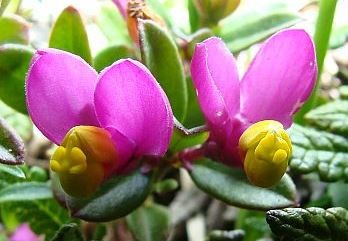Bastard box
(Polygaloides chamaebuxus)

Description
Polygaloides chamaebuxus, synonym Polygala chamaebuxus, the shrubby milkwort, is an ornamental plant in the family Polygalaceae. Its flowers are solitary or in pairs in the leaf axils. The inner two sepals, the wings, are upright and white to yellow, sometimes pinkish or purple. The keel petals are bright yellow, aging to brownish-red or purple. It is native to the Alps and the mountains of west-central Europe. It was known to be grown in cultivation in about 1658 and was illustrated by Carolus Clusius. It has been given the Royal Horticultural Society's Award of Garden Merit. Several cultivars are also cultivated for garden use, including 'Grandiflora', whose flowers are purple-red and yellow. The plants are hardy, forming low-lying clumps up to 6 inches (15 cm) high and 20 inches (51 cm) in diameter. They may be propagated from softwood cuttings taken in early in the growing season. Some varieties grow best in ericaceous conditions. Polygala is a large genus of flowering plants belonging to the family Polygalaceae. They are commonly known as milkworts or snakeroots. The genus is distributed widely throughout much of the world in temperate zones and the tropics. The genus name Polygala comes from the ancient Greek "much milk", as the plant was thought to increase milk yields in cattle. As traditionally circumscribed, Polygala includes annual and perennial plants, shrubs, vines, and trees. The roots often have a scent reminiscent of wintergreen. The leaf blades are generally undivided and smooth-edged, and are alternately arranged in most species. The inflorescence is a raceme or spikelike array of several flowers; the occasional species bears solitary flowers. The flower is bilateral in shape, with two large petal-like sepals on the sides, often called the "wings", and three smaller sepals behind. There are three petals in shades of reddish purple, yellow or white, which are joined at the bases. The lower of the three is the keel petal, which is "boat-shaped, cucullate (hood-like), or helmet-shaped". The keel petal may have a beak or a fringe on the tip. Stamens and style are within the curve of the keel petal. The fruit is a capsule, sometimes winged. It contains two seeds, which are usually black, hairy and tipped with a large white aril. No members of this genus are known to form nitrogen-fixing nodules.
Taxonomic tree:







